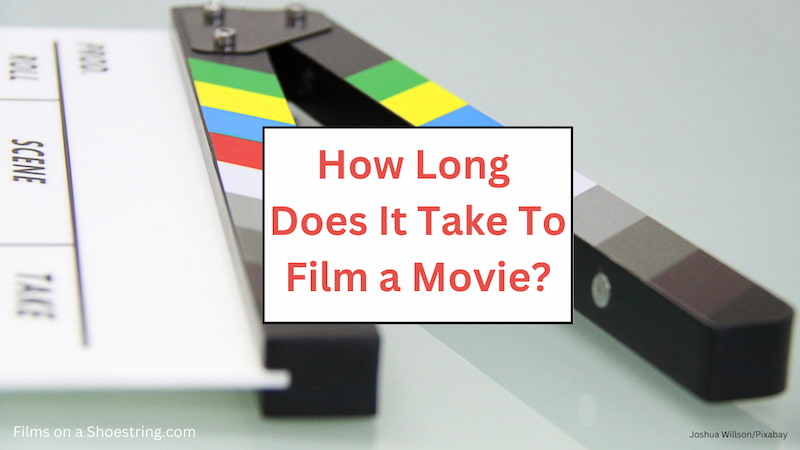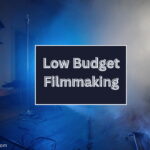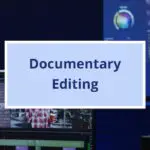There’s no easy answer to the question of how long does it take to film a movie, but it’s usually a much longer and more complicated process than most people expect.
Concept Development
Developing a movie concept and scriptwriting is a crucial and time-consuming part of the filmmaking process. Most of the concepts that take months of work come to nothing.
It usually begins with a vague idea or story that gradually takes shape as the scriptwriter envisions its plot, characters, and dialogues. The film script structure establishes how the story is to be revealed.
The pace of concept development and scriptwriting largely depends on individual circumstances and commitment to the project.
The development phase consists of refining the concept and screenplay through collaboration between the screenwriter(s), producer, studio, and/or director.
This stage involves rawing up the film synopsis, containing the film’s title, genre, logline (a one-sentence summary), and a five-paragraph explanation of the film’s storyline, major plot points, and key characters.
The length of the development phase in filmmaking may vary greatly depending on various factors such as the origin of the story idea, the depth of the story, the writer’s experience and contacts, and the resources available.
Studio movies have the contacts and resources on tap to get through a development process faster, but the number of hurdles with competing projects may make development a longer process than experienced by a talented and well connected independent team driving forward one passion project.
Financing & Meetings
Securing finances for a movie project is an essential part of the filmmaking process. Typically, once a reasonable script has been produced, the film producer takes on the responsibility of organizing meetings to ensure proper funding for the film.
During this time, producers navigate the complex world of film financing to ensure their project receives the necessary budget for the film production to move forward.
Financing is tied into the value of the household name actors taking the lead roles. Who the star is determines how many people will want to watch the movie.
The more famous the film star, the bigger the potential audience for the movie, increasing the chances that the production will make a healthy profit.
Producers and directors have meetings with relevant movie stars to see if they would be interested in the production. Sometimes it’s a yes and the star remains on board, sometimes they say yes but then drop out because of schedule conflicts or other reasons, and sometimes it’s a no so more potential leads must be approached.
Obtaining financing for the project is the crucial part of this phase, and this time-consuming process may differ significantly depending on whether the script was commissioned by a studio or independently written and purchased. Pitches to aggressgates and platforms such as Netflix can start at this stage, although selling often happens after post production too.
The length of this phase depends on various factors, such as whether the script was commissioned by a studio, or if it was independently written and later picked up for production. From the development and funding complexities, you’ll see why filmmakers are considered artists, managers and entrepreneurs.
Pre-Production Planning
Once the script, funding and lead actors are in place, pre-production starts, where preparations are made before the cameras start rolling.
It involves the development of a detailed plan for all aspects of the project, including scripting, scheduling, budgeting, and crew and equipment needs.
Pre-production can be a lengthy process, depending on the complexity and scope of a project, and will last months rather than weeks. A one-location live action shoot takes a shorter pre-planning process than a huge budget cgi fantasy tale across many worlds.
The schedule outlines the day-to-day, week-by-week, and month-by-month tasks that need to be completed, ensuring a smooth production flow. A comprehensive and accurate time schedule is indispensable for a successful movie production, minimizing the risk of unexpected challenges and keeping the project on track.
The budget is broken down to all the many and various departments and their staff and equipments requirements.
The length of the pre-production process varies. Factors such as script length, genre, locations, cast requirements and budget all have a major impact on timescales.
There are a lot of creative aspects to be decided on when storyboarding, including the 180 degree rule, colour temperature and white balance to be applied later in post-production editing, and the camera angle for each scene.
But there are also a huge range of decisions to make about appearance, location etc, with key tasks during pre-production including:
- budgeting, accounting & payroll
- insurance, safety & legal
- rights reserved and copyright issues
- key creative decisions
- storyboarding
- location scouting
- permits for locations
- script revisions
- call sheets
- staffing for all film crew departments
- equipment for all the departments
- casting actors
- rehearsals & scene blocking
- crowd casting
- chaperones
- props, wardrobe, hair & makeup
- set building
- catering
- security
- drivers
- hotels
Pre-production for a movie requires a similar process to organising a short film with no budget, just with many more complicated and expensive parts. The collaborative efforts of multiple departments work together to ensure that each element is perfect and ready as per the production schedule.
Location scouts face the challenge of finding real-life venues that match the vision of the director and the script, while also providing the technical, logistical and practical environment needed by everyone from the electrical department to the extras.
This can be complicated for a movie with lots of locations, busy locations, or if there will be a large number of cast and crew present.
Certain movie genres require specialist skills. For example, for scenes set in the 1940s, the make up artist must reproduce a convincing look for the era. Poor execution of lipstick could spoil the scene when viewed on the big screen.
Meanwhile the safety of all the cast and crew must be considered and planned for in advance. There are a lot of extra rules to keep kids on set free from harm.
Principal Photography
Principal photography is a critical phase in the filmmaking process, during which the film is actually shot. On average, it takes around 106 days to complete principal photography for a Hollywood studio movie. However, the duration may vary depending on the genre and scale of the film.
Principal photography for a movie, when the cameras are rolling, usually takes at least six weeks, and can last four months or so. It’s the shortest part of the production process, but is the most expensive as all the cast, crew and equipment are now present.
The process of principal photography is not only time-consuming but also expensive. Each crew member has a day rate, actors must be paid for the days they are on set, and various resources like food, equipment rentals, and studio spaces are paid for. These costs add up significantly, making it imperative to maintain a strict shooting schedule and production timeline.
The screenwriter and script editor are just as hard at work during this period, doing rewrites at very short notice, including overnight.
During this process, all of the elements planned in pre-production are brought together and recorded on film.
Animated Movies
Animated movies take a lot longer to shoot than live action films.
It’s also worth noting that the filmmaking process used by Pixar has involved significant technological advances as part of the production process, which adds significant time for creation, testing, development and implementation.
Post-Production Editing
Once filming is complete, the editing and post-production process begins. This is when the raw footage is cut and shaped into the desired product.
Special effects teams create the cgi and other visual effects, adding them to the motion picture live recorded scenes. A big screen feature film with many CGI effects will take much longer to complete post-production editing than a simple live action film with few visual effects.
The final product must be visually and narratively engaging. It’s a mixture of the pre-production efficiency and post-production skill which turns raw footage into a story worth watching.
This generally includes putting together the different shots and scenes with careful editing, color grading, sound mixing, and music composition.
Sound mixing and music composition are done to enhance the story using ADR, foley sounds, Rerecording & SFX sound effects by specialists including foley mixers and a professional musician. If you want to understand more about this, see the Hobbit Sound Recording team at work.
Final Review and Release
The aim of almost every independent film and big budget movie, whether its a short movie or 2 hour feature film, is to do well in the film festival circuit.
Each film festival win can be used in marketing materials, which signals to potential audiences that the production is worth watching.
News outlets across the world report on the very big film festival wins, including the Academy of Motion Picture Arts and Sciences (better known as the Oscars), and the Cannes Film Festival. These glamorous affairs don’t just bring in the stars of big budget American films, but also key players across the film industry, because they are a chance to do business.
So, for example, among the yatchs and cocktail parties of the Cannes film festival are multiple meetings about the development and buying and selling of movies.
With or without film festival involvement, producers and directors hold pitches and meetings to get upcoming and post-production projects planned into cinemas and movie theatre schedules, although few movies make much money from appearing on the big screen. Often, the real aim is for sale to a rental or streaming platform.
By the time the movie reaches it final release date, typically two years or more will have passed since the concept was first discussed.
How long does it take to film a movie?
On average it takes between one and two and a half years to film a movie, but this can vary wildly between individual productions.
How long does it take to make a 2 hour movie?
A two hour movie of around 120 minutes will take about 3 to 8 months to film, but development, pre-production and post-production will add at least a year to completion. Few movies are much longer than 2 hours.
How long does it take to make a 90 minute movie?
A 90 minute movie, which is at the shorter end of the average movie length, will take about six weeks to film if the budget is limited. Concept and development, pre-production and post-production will add at least a year to the project.
More on Filmmaking
- Low Budget Filmmaking: More for Less
- Lighting Department Film Roles
- Shooting An Interview
- Documentary Editing
- What is Sound Design in Film?
- Color Grading for Documentary Series or Film
- Film Set Etiquette: Professional Behaviour on Set
- Observational Documentaries And Their Impact
- Essential Skills for Film Industry Professionals
- How to Create a Storyboard in 6 Simple Steps
- What Makes a Film Successful
- Breaking into the Film Industry without Experience
- Sports Documentary Filmmaking
- How to Create a Storyboard Using Sticky Notes
- Remove Background Noise From Video
- Why Do Filmmakers Use Clapper Boards?
- Indie Films
- Indie Filmmaking
- What is Post Production in Film
- Ken Burns Effect: Creating Eye-Catching Sequences






















